
Stepping out into the street after a recent screening of Touching the Void, I was hit by an Arctic blast and my program notes went whooshing down Broadway. For winter-locked New Yorkers, the most appropriate movie to see right now is this docu-drama about Joe Simpson and Simon Yates, who scaled the near-vertical 20,800-foot west face of the Siula Grande mountain in the Peruvian Andes in 1985. It’s cold comfort.
Simpson and Yates are the type of men usually described as a breed apart. Depending on your point of view, this can either mean superhumanly heroic or just plain bonkers. I see it both ways, and clearly so does the director, Kevin Macdonald, who painstakingly reproduced their climb (in the Alps) and thus fits into the heroic-nut category himself. Employing two actors who are also experienced climbers—Brendan Mackey as Simpson and Nicholas Aaron as Yates—Macdonald and his stripped-down crew (and 80 donkeys) endured twenty-below conditions during the worst snowstorm in ten years. Most movies of this type re-create the action far from the actual scene of the crime, but Macdonald has invented a new subgenre: a docudrama in which the docu and the drama are equally authentic. The effect is doubly puzzling because the real Simpson and Yates are periodically interviewed, in the cozy indoors, and it is they, and not the actor–climbers, who seem unreal. While they relate their odyssey, their doppelgängers are dangling precariously over crevasses.
The reason the Simpson–Yates climb has become enshrined in the mountaineer’s hall of infamy is that, following a successful three-day ascent, Simpson was crippled by a fall, his lower leg pushing through his knee joint. Yates was able to lower Simpson down the mountain on a rope 300 feet at a time, but, without food or water or means to contact anyone else, he realized time was running out. Caught in a ferocious blizzard, he had no idea if Simpson was still alive, and meanwhile, Simpson’s weight was pulling him off the mountain. So he cut the rope—the ultimate mountain-climbing taboo.
Since Simpson is on camera to tell the tale—which he already wrote up as a best-seller in 1988—I give nothing away here by saying that he survived. Both as movie and as book, Touching the Void is, in part, Simpson’s exoneration of Yates. As he says in the film, most climbers would have made up a phony excuse to leave their crippled partner behind and get “help”; at least Yates did all that he could do until his own life seemed over. Normally, I would be suspicious of such noble sentiments coming from someone who had every right to feel betrayed, but Simpson is nothing if not pragmatic. He says he would have done the same thing as Yates, and you believe him. His pragmatism is what saved him. Certainly, it wasn’t his religious faith—when the endgame arrived, this lapsed Catholic had no trust in an afterlife. Shattered, frostbitten, he managed to extricate himself from the icy vaults he had fallen into and make his agonized crawl back to base camp.
As a piece of inspirationalism about human stamina, Touching the Void is peerless, but what it doesn’t—perhaps can’t—explain is why people place themselves in such peril. It’s one thing to observe someone enduring, say, the carnage of war, or mortal illness, but Simpson and Yates, knowing full well the odds, chose their path. Our admiration for what they accomplished is tempered by the realization that they were entirely responsible for being caught on the mountain in the first place. I realize this is a very un–Sir Edmund Hillary way to sound. So be it. But when Yates tells us that he climbs because he wants to get away from the world’s clutter, I find myself on the side of the pack rats.